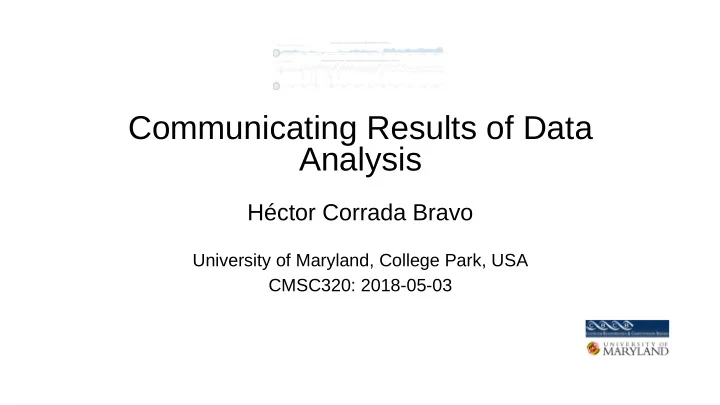

Communicating Results of Data Analysis Héctor Corrada Bravo University of Maryland, College Park, USA CMSC320: 20180503
For Today Data Analysis Deliverables: Written analyses R packages 1 / 13
Written analyses 1. Title 2. Introduction and motivation 3. Description of dataset 4. Description of statistical and machine learning models used (Methods) 5. Results (including measures of uncertainty) 6. Conclusions (including potential problems) 7. References https://leanpub.com/datastyle 2 / 13
Written analyses Introduction and Motivation Always lead with the question (task) you are addressing. E.g.: "Can we use tweets about stocks to predict stock prices?" Not: "Can we use the Random Forest algorithm to learn a classifier that predicts stock prices" E.g: "What are good predictors of student performance?" Not: "Can we use linear regression to predict student performance" 3 / 13
Written analyses Description of dataset Size: entities and attributes Important: describe what you did to 1) obtain, 2) tidy the dataset. 4 / 13
Written analyses Description of data analysis methods Be specific, use equations when appropriate: W = a + bH + e where is weight , is height and is an error term. W H e When appropriate mention distributional assumptions on . e 5 / 13
Written analyses Description of data analysis methods When using ML methods, describe: preprocessing (e.g., feature selection, transformations) algorithm choice (why is it appropriate) model selection and assessment (e.g., which classification metric and why) 6 / 13
Written analyses Results Report estimates in the appropriate units Report estimates with uncertainty We saw confidence intervals on our previous lectures with specific advise regarding their presentation. ( Note : this also applies to prediction metrics) 7 / 13
Written analyses Results Important : Summarize importance of estimate (i.e., refer to the question you originally posed in introduction) Why does this estimate address your question? 8 / 13
Written analyses End matter Include potential problems with the analysis you carried out. Include references to the analysis methods used. 9 / 13
Graphics Karl Broman's presentation on effective graphics: http://tinyurl.com/graphs2017 10 / 13
Graphics A few other notes on style: Make titles legible Annotate in plot if possible (see example data analysis early in semester) Include units in axis titles when appropriate E.g., not appropriate in PC scatterplot 11 / 13
R packages Case study: suppose you used data to create a classifier for diagnostic purposes. How do you share? R packages is a reproducible, highvisibility way of publishing these types of results Consistent organization Standardized deployment 12 / 13
R packages Case study: suppose you used data to create a classifier for diagnostic purposes. How do you share? R packages is a reproducible, highvisibility way of publishing these types of results Hadley's presentation on R packages http://www.slideshare.net/hadley/rpackages The book 13 / 13
Recommend
More recommend